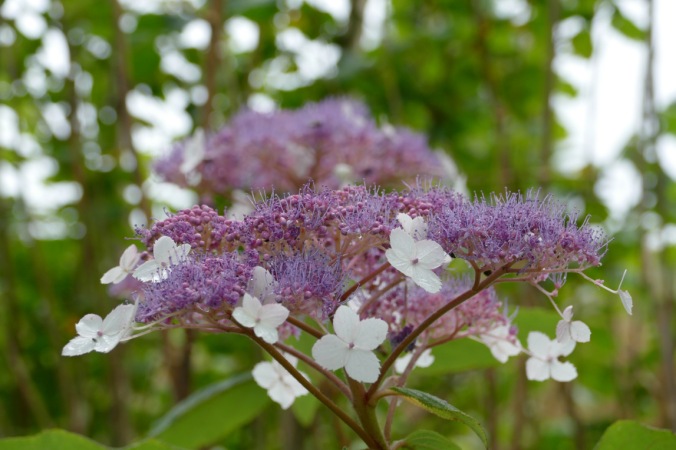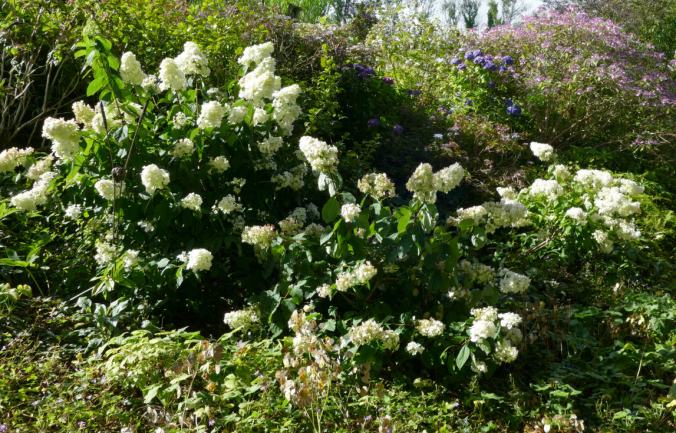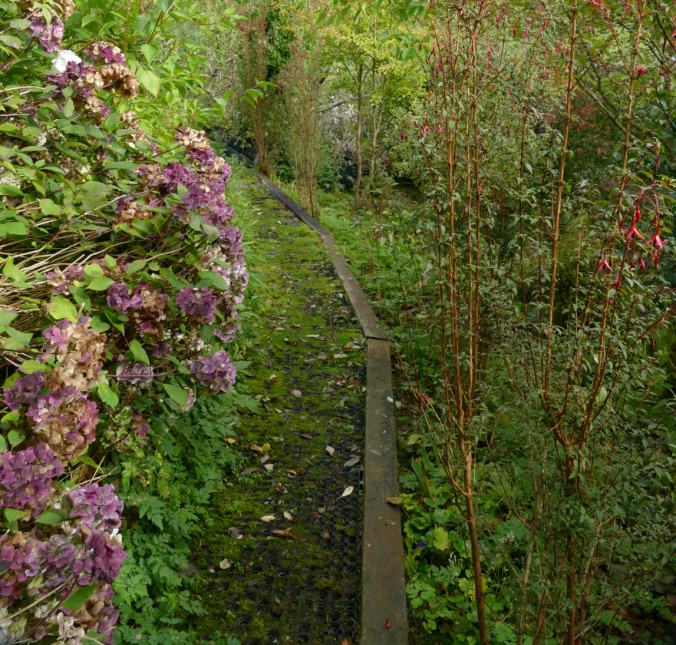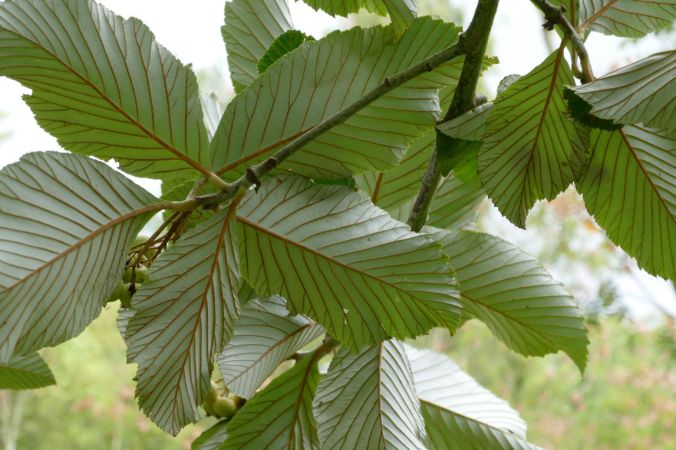Many thanks to Yvonne for her notes on Richard Bramley’s timely talk “Autumn into Winter” to Cothigardeners in September which we were sadly unable to make, but which was well attended and enjoyed by all.
Richard covered great plants for good autumn colour including Acers, Berberis, Euonymus and Cornus racemosa which has black autumn foliage.
Colourful winter stems from Cornus species and Salix (willow) can add to interest.
Hydrangea flower heads last well into autumn, even as colours fade. Some forms even flower late like the above form of H. aspera, in bloom in early October. Look out for the Forever series, as they keep on flowering. Cut down Hydrangea Annabelle to the ground in spring as it’s a herbaceous variety so flowers on the current year’s wood, as do H. paniculata varieties.
H. macrophylla flowers on last year’s wood, which may get frosted in spring, so killing the flower buds.
Other good plants for autumn are Lespedezia, Aconitum. Fuchsia magellanica, Astrantia, Campanula – if they are given the Chelsea chop (prune the height by a third in Chelsea Flower Show week), these plants will flower later on shorter stems.
Hardy Chrysanthemums sold in the autumn as domes of flowers, should be treated as bedding. Herbaceous Chrysanthemums should be hardy and are a good addition to the garden.
Some Asters (Michaelmas Daisies) can get mildew due to dry or stress (nova belgii types). Closely allied to Asters are Kalimeris, which are good plants, along with other Asters.
Annual Rudbeckia and perennial Rudbeckia are excellent plants for the autumn, but they can get very tall. Cut them down on the longest day and they will flower a little later on shorter stems. Heliopsis, Leucanthemella will grow in shade. Persicaria amplexicaulis is a pretty thug, and needs to planted somewhere where spread is required.
Viola cornuta, the smaller the flower, the hardier the plant. Salvia species, long flowering but not hardy, can extend flowering up to frosts but take cuttings a.s.a.p. to overwinter ready for the following year. Solidago x aster is another good plant and not at all boring.
Grasses can extend a season of interest right through winter, and can be successfully mixed in with herbaceous plants rather than a bed of grasses. Panicum species have a lovely arching habit. Stipa gigantea, above, is another good grass, and doesn’t self seed. Pennisetum varieties, treat as annuals, though they can be overwintered in a cold greenhouse or polytunnel. Cardoons also have wonderful seed heads in winter. Don’t be too quick to tidy in the autumn, as the frost on grasses, cardoons, etc give a new dimension to the garden. They also protect the roots from frost, and give cover to insects, hedgehogs, etc.
 The trip which Fiona had organised with Stephen and Mel Lloyd for Cothi Gardeners to visit the Hergest Croft garden for a combined guided tour and seed/cutting collection was a huge success. We were really fortunate with a benign weather slot in what has been the wettest spell for months, and were thrilled that Steve was so generous with his time and advice, whilst Mel provided us all with bags, and names to record the many seeds, fruit and cuttings we were able to collect in a two and a half hour walk.
The trip which Fiona had organised with Stephen and Mel Lloyd for Cothi Gardeners to visit the Hergest Croft garden for a combined guided tour and seed/cutting collection was a huge success. We were really fortunate with a benign weather slot in what has been the wettest spell for months, and were thrilled that Steve was so generous with his time and advice, whilst Mel provided us all with bags, and names to record the many seeds, fruit and cuttings we were able to collect in a two and a half hour walk.
Hergest Croft is such a special place with one of the finest collections of trees and shrubs in the British Isles including national collections of hundreds of different Sorbus, Betula and Zelkova, as well as being wonderfully peaceful and beautiful whatever time of year one visits.
Steve demonstrated it’s always worth cutting into a few seeds just to check if they’ve got viable white/green centres. Sometimes a tree will be laden with seeds which look fine, but are in fact empty and will never germinate. Also he pointed out some of the trees where it’s best to save seed from the tree (e.g. Acers and Sorbus) and others (e.g. Magnolias and Davidia) where it’s better to collect from seed or fruit that’s fallen to the floor.
Click here for more about Hergest Croft, and there’s still time to plan a visit for their special autumn plant fair on Sunday October 13 th – Hergest Croft Autumn Fair, Ridgebourne Road, Kington, Herefordshire HR5 3EG with over 40 plant and craft stalls. Open 10-4.30pm. Admission £6.50.
What I didn’t know before Stephen told us, as we walked through the garden’s glades and reached the top of the Sorbus collection, is that the garden rises to over 1,000 feet above sea level, so many of the well labelled trees which are indigenous to China and the Himalayas will be quite comfortable with the conditions here.
Stephen, the Head gardener in a team of 5 who manage the 70 acres, has worked as a gardener at Hergest for 40 years, and has grown many of the now mature and rare trees from seeds sent to Hergest from collectors around the world.

 So to have him passing on his tips as to how best to choose and propagate material was a rare treat, and all this in a year when many trees were laden with berries and seeds after a bumper year for pollination and fruit production.
So to have him passing on his tips as to how best to choose and propagate material was a rare treat, and all this in a year when many trees were laden with berries and seeds after a bumper year for pollination and fruit production.


Thanks very much to Stephen and Mel for their very warm welcome and generosity and for making it such a very special day. We look forward to letting them know in due course how well we get on with the propagation, once we get all the material prepared for sowing …
A reminder that this month’s meeting on Wednesday October 16th at 7.30 pm is by Neil Barry on “The Plant Hunters and Explorers”. Do arrive in good time for refreshments and a catch up before we start.
Neil is originally from County Cork in Ireland and is now living near Swansea.
He trained at the Royal Botanic Gardens, Kew for three years whilst also studying for his horticulture qualifications at Capel Manor College near London and Berkshire College of Agriculture. After completing training at Kew, he moved in to teaching horticulture and completed a Post Graduate Diploma in Education. He has been a lecturer in Horticulture for 8 years, most of which was at Neath Port Talbot College but has also taught at The National Botanic Garden of Wales and elsewhere.
Finally a date for your diaries – our annual Christmas meal will be on Wednesday December 11th lunchtime at the Forest Arms Brechfa, our very successful venue last year. We should have a final menu available soon, and will need names and deposits shortly and hope that many of you will be able to make it for what’s always an enjoyable event.



Ha! That sorbus is rad! I just read about someone else’s sorbus. I suppose it is that time of year. I have never seen a mature specimen. I just got my first two small rooted cuttings a few years ago. Those that I got are known as mountain ash. Goodness, I can not remember the species. They might be known as rowan like other sorbus are in other cultures. I do not know if there is a difference between mountain ash and rowan.
LikeLiked by 1 person
Thanks Tony, Over here the common Sorbus (acuparia) species is known both as Mountain Ash and Rowan, as well as a few other “common names” local to different parts of the UK,
Best wishes
Julian
LikeLiked by 1 person
It occurred to me that mine are Sorbus americana. The common names can be only so common for something so rare, but happen to be the same as yours.
LikeLike